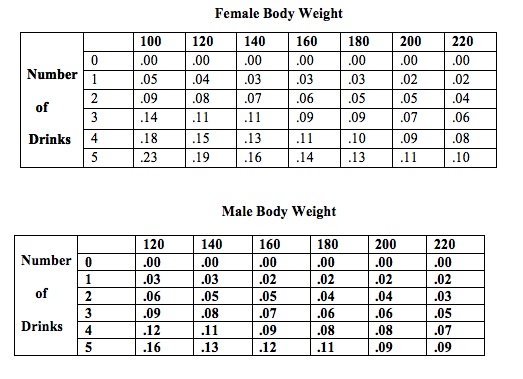What is Blood Alcohol Content?
12/26/14
Alcohol gets absorbed into our blood through our intestines and stomach lining. BAC is a measurement of how much alcohol has passed through and is now flowing in the blood throughout our entire body. A Breathalyzer test is often used by law enforcement and is considered a standard tool to measure BAC; it is considered accurate enough to be allowed into evidence into a court of law. Every 45 minutes, someone in the United States is killed from an alcohol-related automobile accident.
| Blood Alcohol Concentration (BAC) |
Typical Effects | Predictable Effects on Driving |
| .02% |
|
|
| .05% |
|
|
| .08% |
|
|
| .10% |
|
|
| .15% |
|
|
| provided by nhtsa.gov | ||
Does drink choice influence a person’s BAC?
The type of alcohol consumed does not make any noticeable difference in BAC measurements. A typical drink is considered to be .54 ounces of alcohol. One shot of distilled alcohol, a 5-ounce glass of wine, or a standard 12-ounce beer all consist of approximately a half-ounce of alcohol.
What influences a person’s BAC?
The amount of body fat an individual has for their total weight affects how much alcohol will end up in the bloodstream. Women generally have more fat cells than men; alcohol is not absorbed into fatty tissue and so becomes more concentrated in the bloodstream. Further, the faster you consume alcohol, the higher your BAC will be. It is best to spread your drinks out over a number of hours.
When are you considered to be impaired?
In all 50 states, the legal limit for BAC is a .08. By the time an individual reaches a BAC of .05, alcohol has a sedative effect on your body and begins to noticeably slow reaction time. If you are under 21, it should be expected that being caught with any alcohol in the blood while driving would result in a DUI. It is always best to have a designated driver to avoid any arrests even if you believe you are okay to drive.
As seen from the chart above, it is very easy to be above the legal limit. Most people are close to or above the legal limit after only two drinks. If you choose to drive you will be subject to arrest.
Fort Lauderdale Criminal Defense Attorney Kenneth Padowitz
In these situations, an aggressive criminal defense attorney will be indispensable. A good defense starts before a prosecutor has the chance to file charges. If you need DUI help, contact Kenneth Padowitz today. His legal expertise gained through past experience prosecuting similar charges has given him a broad range of knowledge about DUI offenses and laws.



